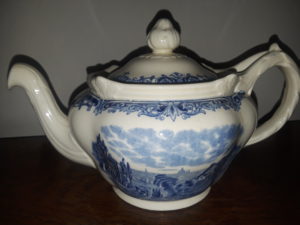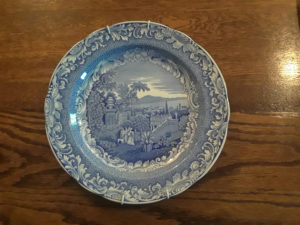 Lately, I’ve been downsizing, but as well as donating things, I’ve been replacing a few of them with pieces that I like better. This weekend, I found this cute teapot at a local Thrifty Shopper. It’s from Grindley, an English pottery, and is part of the “Scenes After Constable” series.
Lately, I’ve been downsizing, but as well as donating things, I’ve been replacing a few of them with pieces that I like better. This weekend, I found this cute teapot at a local Thrifty Shopper. It’s from Grindley, an English pottery, and is part of the “Scenes After Constable” series.
It’s a nice addition to my growing collection of intentionally mismatched blue-and-white transferware. Since I don’t care about the age and want everything to be in good, usable condition, the vast majority of my pieces are relatively new and inexpensive. I like that because I don’t want to have to worry about it if someone breaks a dish, but I also love that many of my finds are reproductions of patterns from around the Regency era.
Wanting to learn more about transferware, I found the Transferware Collectors’ Club. According to their website, transferware is “the term given to pottery that has had a pattern applied by transferring the print from a copper plate to a specially sized paper and finally to the pottery body.” It was developed in the middle of the 18th century as an alternative to the more expensive hand-painted ware that was also popular at that time. So it could easily have been used by characters in our stories.
The earliest patterns were copies of Chinese blue and white designs, but soon the English potteries began producing other designs including florals, English landscapes, classical scenes, and the like, and have continued to do so. For instance, Enoch Wedgwood came out with a “Liberty Blue” series in 1976. Although most of my collection is of English scenes, I have a few of these, as well as some of the popular “Blue Willow” pattern.
Blue and white is still very popular (and my favorite) but transferware can also be found in red, green, purple, and brown.
 Here’s one of my plates that is of Regency interest. It’s one of the “Byron’s Views”, part of the Spode “Blue Room” collection. This design came out in 1833. Mine is a reproduction, of course. You can learn more about transferware and other types of pottery at the Spode and Wedgwood museum sites.
Here’s one of my plates that is of Regency interest. It’s one of the “Byron’s Views”, part of the Spode “Blue Room” collection. This design came out in 1833. Mine is a reproduction, of course. You can learn more about transferware and other types of pottery at the Spode and Wedgwood museum sites.
And here’s where I keep my china and crystal inventory, so I know what I have and what I’m still looking for (cereal and soup bowls, mostly).
What do you enjoy collecting?
Elena

[…] My blue and white collection Lately, I’ve been downsizing, but as well as donating things, I’ve been replacing a few of them with pieces that I like better. This weekend, I found this cute teapot at a local Thrifty Shopper. It’s from Grindley, an English … Continue reading → […]